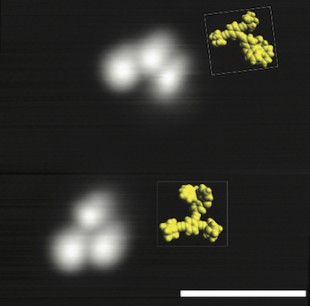
A scanning tunneling microscope image shows two three-wheeled nanoroadsters.
Image: Alex Saywell/Leonhard Grill
Past ECS lecturer James Tour and his team at Rice University have developed a tiny three-wheeled, single-molecule call they’ve dubbed the “nanoroadster.”
This new research builds on Tour’s light-driven nanocars, which he developed six years ago. Since then, additional research efforts have allowed researchers to drive fleets of the nanoroadsters at once.
“It is exciting to see that motorized nanoroadsters can be propelled by their light-activated motors,” Tour says. “These three-wheelers are the first example of light-powered nanovehicles being observed to propel across a surface by any method, let alone by scanning tunneling microscopy.”
This from Rice University:
Rather than drive them chemically or with the tip of a tunneling microscope, as they will do with other vehicles in the upcoming international NanoCar Race in Toulouse, France, the researchers used light at specific wavelengths to move their nanoroadsters along a copper surface. The vehicles have rear-wheel molecular motors that rotate in one direction when light hits them. The rotation propels the vehicle much like a paddle wheel on water.
“If we have to ‘wire’ the car to a power source, like an electron beam, we would lose a lot of the cars’ functionality,” Tour says. “Powering them with light frees them to be driven wherever one can shine a light—and eventually we hope they will carry cargo.”
The ability to activate multiple fleets of nanocars at once opens possibilities of using nanomachines like ants, in which they could work collectively to perform some construction.

